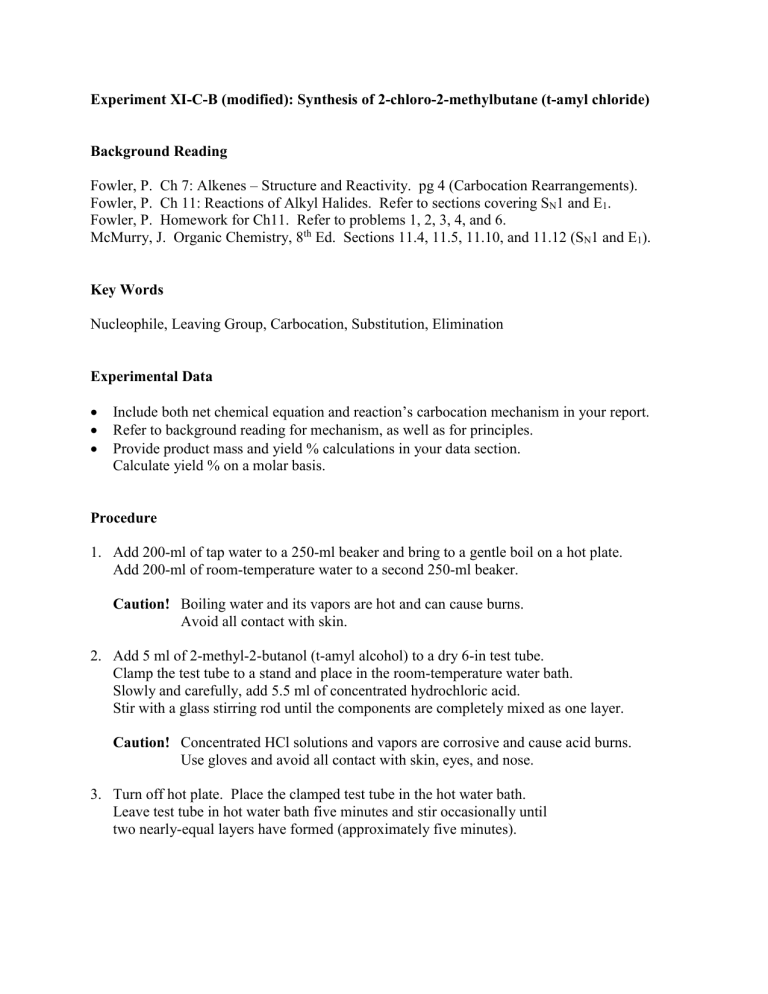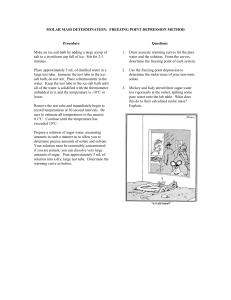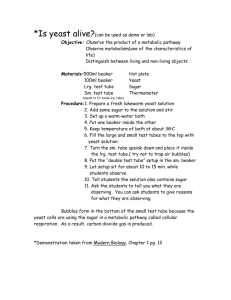(modified): Synthesis of 2-chloro-2-methylbutane (t

Experiment XI-C-B (modified): Synthesis of 2-chloro-2-methylbutane (t-amyl chloride)
Background Reading
Fowler, P. Ch 7: Alkenes – Structure and Reactivity. pg 4 (Carbocation Rearrangements).
Fowler, P. Ch 11: Reactions of Alkyl Halides. Refer to sections covering S
N
1 and E
1
.
Fowler, P. Homework for Ch11. Refer to problems 1, 2, 3, 4, and 6.
McMurry, J. Organic Chemistry, 8 th
Ed. Sections 11.4, 11.5, 11.10, and 11.12 (S
N
1 and E
1
).
Key Words
Nucleophile, Leaving Group, Carbocation, Substitution, Elimination
Experimental Data
Include both net chemical equation and reaction’s carbocation mechanism in your report.
Refer to background reading for mechanism, as well as for principles.
Provide product mass and yield % calculations in your data section.
Calculate yield % on a molar basis.
Procedure
1.
Add 200-ml of tap water to a 250-ml beaker and bring to a gentle boil on a hot plate.
Add 200-ml of room-temperature water to a second 250-ml beaker.
Caution!
Boiling water and its vapors are hot and can cause burns.
Avoid all contact with skin.
2.
Add 5 ml of 2-methyl-2-butanol (t-amyl alcohol) to a dry 6-in test tube.
Clamp the test tube to a stand and place in the room-temperature water bath.
Slowly and carefully, add 5.5 ml of concentrated hydrochloric acid.
Stir with a glass stirring rod until the components are completely mixed as one layer.
Caution! Concentrated HCl solutions and vapors are corrosive and cause acid burns.
Use gloves and avoid all contact with skin, eyes, and nose.
3.
Turn off hot plate. Place the clamped test tube in the hot water bath.
Leave test tube in hot water bath five minutes and stir occasionally until two nearly-equal layers have formed (approximately five minutes).
4.
Once the second layer has stopped growing, use a glass pipette to transfer the upper layer (product is 0.866 g/ml) to a second test tube. Do not leave the two layers standing together because the product will react with water.
Add approximately 0.1 to 0.2 g of drying agent to the test tube with the product.
The drying agent will be anhydrous Na
2
CO
3(s)
, K
2
CO
3(s)
, or MgSO
4(s)
.
Note the presence of bubbles forming with the carbonate drying agents.
Place a rubber stopper (#1 or #2) on the test tube.
Allow the stoppered test tube to stand for ten minutes.
If the product does not become clear, add more drying agent and allow the test tube to stand for five more minutes.
Do not discard the hot water bath. It is needed in the next step.
5.
Decant the liquid into a 25-ml round-bottom flask and add a boiling stone.
Assemble simple distillation apparatus for the flask with a water-cooled condenser.
Use a hot water bath (initially at ≥ 70 o
C) for the heat source. Do not use a heating mantle.
Place thermometer so that the bulb is just below the junction in the distillation head.
Use a waste beaker to collect the forerun (E1), if any, which distills below 50 o
C.
Discard the forerun once you are sure that it is not your product.
Weigh a small bottle or 25-ml Erlenmeyer flask and use as the product receiver.
Collect the product that distills with the head temperature above 60 o
C (BP is 85 - 86 o
C).
Do not continue the distillation past 86 o
C.
Caution! Never distill to dryness as this is dangerous.
This could cause glassware to char, crack, break, or even cause an explosive mix of vapors to form.
6.
Weigh your product and analyze it with an infrared (IR) spectrophotometer.
Identify the following absorptions on your spectrum: 1460, 1380, 1149, 800, and 560 cm
-1
.
Waste Disposal
Place all solutions and used drying agents in appropriately labeled waste jar(s).
Post-Lab Questions
1.
Water can potentially cause two competing reactions with the carbocation.
Diagram both and state their mechanism types.
2.
Determine which of the two side products in question 1 would be a forerun in the distillation and which would distill at a higher temperature than the actual product. (See step 5.)
3.
Explain why carbocation rearrangements are not observed in this experiment.
4.
If anhydrous Na
2
CO
3(s)
is used as a drying agent, an acid-base reaction occurs with H
3
O
+1
, and a gas is evolved. Write the balanced net ionic equation for this reaction.
5.
The common name for the product is t-amyl chloride. Explain what t-amyl means.







